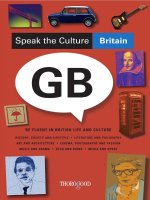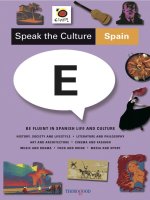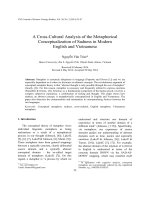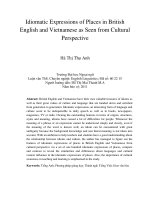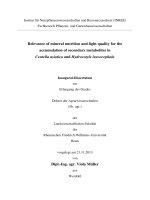speak the culture britain be fluent in british life and culture
Bạn đang xem bản rút gọn của tài liệu. Xem và tải ngay bản đầy đủ của tài liệu tại đây (26.85 MB, 372 trang )
Speak the Culture Britain
v6 STC BRITAIN:Layout 1 25/3/10 13:26 Page 1
v6 STC BRITAIN:Layout 1 25/3/10 13:26 Page 2
www.thorogoodpublishing.co.uk www.speaktheculture.co.uk
GB
BE FLUENT IN BRITISH LIFE AND CULTURE
HISTORY, SOCIETY AND LIFESTYLE
•
LITERATURE AND PHILOSOPHY
ART AND ARCHITECTURE
•
CINEMA, PHOTOGRAPHY AND FASHION
MUSIC AND DRAMA
•
FOOD AND DRINK
•
MEDIA AND SPORT
Speak the Culture Britain
v6 STC BRITAIN:Layout 1 25/3/10 13:26 Page 3
All rights reserved.
No part of this publication
may be reproduced, stored
in a retrieval system or
transmitted in any form or
by any means, electronic,
photocopying, recording or
otherwise, without the prior
permission of the publisher.
This book is sold subject
to the condition that it shall
not, by way of trade or
otherwise, be lent, resold,
hired out or otherwise
circulated without the
publisher’s prior consent
in any form of binding or
cover other than in which
it is published and without
a similar condition
including this condition
being imposed upon the
subsequent purchaser.
No responsibility for loss
occasioned to any person
acting or refraining from
action as a result of any
material in this publication
can be accepted by the
author or publisher.
All has been done to trace
the owners of the various
pieces of material used
for this book. If further
information and proof of
ownership should be made
available then attribution
will be given or, if
requested, the said material
removed in subsequent
editions.
A CIP catalogue record for
this book is available from
the British Library.
ISBN: 1 85418 627 2 / 978-
185418627-0
Thorogood Publishing Ltd
10-12 Rivington Street
London EC2A 3DU
Telephone: 020 7749 4748
Fax: 020 7729 6110
www.thorogoodpublishing.co.uk
www.speaktheculture.co.uk
© 2009
Thorogood Publishing Ltd
v6 STC BRITAIN:Layout 1 25/3/10 13:26 Page 4
Special thanks to Lucy Miller,
Kathy Crawford, Ronan Conway,
Dudley Whittaker, Sue Parkin
and Marcus Titley
(www.seckfordwines.co.uk)
Acknowledgements
Neil Thomas
Editorial Director
Angela Spall
Andrew Whittaker
Additional editorial
contributors
Sam Bloomfield
Alexandra Fedoruk
Amy Wilson Thomas
David Banks
Jess Fitch
Paul Sutton Reeves
Johnny Bull
plumpState
www.plumpstate.com
iStockphoto
Nial Harrington
Harrington Moncrieff
www.hmdesignco.com
Printed in the UK by
Henry Ling Ltd
www.henryling.co.uk
Publisher Design & imagesEditor in chief
River Thames from the top
of Tower Bridge at Southwark
looking towards the skyscrapers
of Docklands
v6 STC BRITAIN:Layout 1 25/3/10 13:27 Page 5
Contents
1.1. Geography p5
1.1.1. Britain: what
is it and what does it
look like? p6
1.2. History p15
1.2.1. Come in, make
yourself at home:
Celts, Saxons, Vikings
and Normans p16
1.2.2. The split
personality takes
shape p23
1.2.3. The modern age:
empire, slavery and
sacrifice p31
1.3.
Language and
belonging p43
1.3.1. Language
lessons: how the
British talk p44
1.3.2. Being British:
I wish I’d never asked…
p50
2.1.
Literature p59
2.1.1. How important is
literature to Britain?
p60
2.1.2. Well versed:
Brit lit in the medieval era
p62
2.1.3. From sonnets
to novels: literature
grows up p67
2.1.4. The Romantics
and the realists p75
2.1.5. Success stories:
modern British literature
p84
2.2.
Philosophy p97
2.2.1. The greatest hits
of British philosophy
p98
3.1.
Art and design
p109
3.1.1. Foreign aid:
the early personnel of
painting p110
3.1.2. Morals, mares
and mug shots:
British art finally gets
serious p114
3.1.3. Constable,
Turner and Blake:
the golden age p117
3.1.4. From cubes to
dead sharks: art over
the last century p121
3.1.5. Mixed motifs:
the icons of British design
p130
3.2.
Architecture p135
3.2.1. Picking through
the ruins: ancient British
buildings p136
3.2.2. Built on faith:
the love of a good church
p138
3.2.3. Castles, piles
and factories:
the big builds p144
3.2.4. In and out of
love with Modernism:
20
th
century builds p151
3.2.5. Home truths:
domestic architecture
and planning p155
4.1.
Music p161
4.1.1. Folk stories:
traditional music p162
4.1.2. Flashes of
brilliance: British
classical music p167
4.1.3. Rebel forces:
rock, pop, punk and
the rest p173
4.2.
Theatre, dance
and comedy p185
4.2.1. Setting the scene
for Shakespeare:
how theatre found its
golden age p186
4.2.2. Light brigade:
from Restoration Comedy
to Gilbert and Sullivan
p194
4.2.3. Mirth, musicals
and a good portion of
angst: modern theatre
p200
4.2.4. Britain on the
dancefloor p208
4.2.5. Laughing gear:
modern British comedy
p213
4. Performing
arts p159
3. Art, architecture
and design p107
2. Literature and
philosophy p57
1. Identity: the
foundations of
British culture p3
v6 STC BRITAIN:Layout 1 25/3/10 13:27 Page 6
ebooksdownloadrace.blogspot.in
5.1. Cinema p221
5.1.1. An underdog’s
story: the Brits and
their films p222
5.1.2. From dog stars
to Hitchcock:
early cinema p224
5.1.3. Big films and
bigger audiences:
the golden age p227
5.1.4. From bedsits
to Bond: cinema in the
1960s p231
5.1.5. Let’s hear it for
the little guy: modern
British cinema p234
5.2.
Photography p241
5.2.1. Fixing the
shadows p242
5.2.2. Art, war and
glamour: modern
photography p245
5.3.
Fashion p249
5.3.1. Clothes and the
British sense of style
p250
6.1.
Media p261
6.1.1. Reverting to type:
national and regional
newspapers p262
6.1.2. On the rack:
magazines p266
6.1.3. A love affair
with telly p268
6.1.4. Waves of radio:
from ITMA to Moyles
p272
6.1.5. New media:
Britain on the Web p275
6.2.
Communications
p279
6.2.1. Posting letters
and making calls p280
6.2.2. The age of the
strain: getting about
Britain p282
7.1.
Food p289
7.1.1. The changing
culture of British food
p290
7.1.2. Stews, bakes,
jellies and puds:
the regional menu p294
7.1.3. The lost art of
dining: eating habits
p302
7.2.
Drink p307
7.2.1. Fancy a brew?
Brits and their drinks
p308
7.2.2. Whose round is
it? Drinking habits p315
8.1.
Divided loyalties:
class, race and family
p322
8.2.
How Britain takes
its religion p326
8.3.
Unwritten rules:
politics and the system
of government p331
8.4.
Cashing in: the
economy, wealth and
social security p339
8.5.
Law and order:
courts, prisons and
the police p343
8.6.
Testing times: the
education system p347
8.7.
Time out: holidays,
festivals and free time
p351
8.8.
Cricket to conkers:
a love affair with sport
p356
5. Cinema,
photography and
fashion p219
8. Living culture:
the state of modern
Britain p319
7. Food and drink
p287
6. Media and
communications
p259
v6 STC BRITAIN:Layout 1 25/3/10 13:27 Page 7
v6 STC BRITAIN:Layout 1 25/3/10 13:27 Page 8
1
First, a word from
the publisher…
This series of books and this book are designed to look
at a country’s culture – to give readers a real grasp of it
and to help them develop and explore that culture.
The world is shrinking – made smaller by commerce,
tourism and migration – and yet the importance of
national culture, of national identity, seems to grow.
By increasing your cultural knowledge and appreciation
of a country, be it your own or a foreign land, you reach
a genuine understanding of the people and how they live.
We’re t alking about culture in all its guises: the creative
arts that give a country its spirit as well as the culture of
everyday life.
Speak the Culture books sit alongside guidebooks and
language courses, serving not only as a companionable
good read but also as an invaluable tool for understanding
a country’s current culture and its heritage.
v6 STC BRITAIN:Layout 1 25/3/10 13:27 Page 1
v6 STC BRITAIN:Layout 1 25/3/10 13:27 Page 2
3
1 Identity: the foundations
of British culture
1.1. Geography p5
1.1.1. Britain: what
is it and what does it
look like? p6
1.2. History p15
1.2.1. Come in, make
yourself at home:
Celts, Saxons, Vikings
and Normans p16
1.2.2. The split
personality takes
shape p23
1.2.3. The modern age:
empire, slavery and
sacrifice p31
1.3. Language and
belonging p43
1.3.1. Language
lessons: how the
British talk p44
1.3.2. Being British:
I wish I’d never asked…
p50
1
v6 STC BRITAIN:Layout 1 25/3/10 13:27 Page 3
v6 STC BRITAIN:Layout 1 25/3/10 13:27 Page 4
5
1. Identity: the
foundations
of British culture
2. Literature
and philosophy
3. Art, architecture
and design
4. Performing
arts
5. Cinema,
photography
and fashion
6. Media and
communications
7. Food and drink 8. Living culture:
the state of
modern Britain
1.1 Geography
It’s the original island nation.
Standing aloof on Europe’s western fringe,
battered by some of the world’s roughest
seas, Britain has clung to its detachment
for centuries. From outside it looks
homogenous, defiantly separate from
continental Europe in body and soul.
However, step ashore and it dissolves into a
stew of landscapes, people and cultures.
v6 STC BRITAIN:Layout 1 25/3/10 13:27 Page 5
Table for four please
The British state harbours four nations – Wales, Scotland,
England and Northern Ireland – each with its own distinct
culture. All four nations can be broken down further, into
regions where landscape, language and lifestyle vary
markedly. And then there’s the dense historical jigsaw, from
stone circles to ruined abbeys, each corner of Britain has its
story to tell. Surely no other country so modest in scale is
so regionally pronounced, so packed with cultural variety, so
connected to its past yet steadfastly modern.
So, is it Britain, the United Kingdom or the British Isles?
The term Great Britain, or just Britain (or Breatainn Mhòr in
Scottish Gaelic and Prydain Fawr in Welsh), is usually taken
to mean England, Wales and Scotland. The United Kingdom
throws Northern Ireland into the mix. The British Isles
includes the Republic of Ireland and any island lumps
surrounding mainland Britain. Informally – and for most
Brits – the term Britain is taken to mean England, Wales,
Scotland and Northern Ireland, and is used as such
throughout this book.
Small but beautiful: the lie of the land
Britain squeezes a pleasingly diverse landscape into its
modest frame. Emily Brontë’s feral moorland with its
‘bare masses of stone’ might sound a long way from
William Blake’s ‘pleasant pastures’, but they coexist closely
and comfortably. If we’re looking for a vague rule, the
further north and west you travel the lumpier Britain gets.
Fertile lowlands in south-eastern England are relieved by
soft hills before the West Country breaks out into stretches
of moorland. In northern England the Pennine hills form a
spine running from the Peak District through the Dales up
to the border country with Scotland, while
the winsome peaks of the Lake District cover England’s
north-west. Much of Wales, to the west of England, and
6
1. Identity: the
foundations
of British culture
2. Literature
and philosophy
3. Art, architecture
and design
4. Performing
arts
5. Cinema,
photography
and fashion
6. Media and
communications
7. Food and drink 8. Living culture:
the state of
modern Britain
1.1.1 Britain: what is it and what does it look like?
v6 STC BRITAIN:Layout 1 25/3/10 13:27 Page 6
Scotland, to the north, are mountainous. Scotland
harbours the Highlands and Islands, rare in Britain
for retaining an element of wilderness. Only these
northerly uplands, rugged, boggy and cold, escaped
the centuries of farming that tamed Britain’s
countryside, native deciduous forests included. Across
the Irish Sea, west of southern Scotland, lies Northern
Ireland, a land of bare, peaty hills encircling Lough
Neigh, the largest freshwater lake in the British Isles.
Counting counties
Britain breaks down into a complex map of regions,
counties, boroughs, districts, unitary authorities and
parishes. Some are historic and familiar but unofficial;
others are new and sanctioned by government but
rarely used in conversation. Each of the four British
nations has been divided into counties (so called
because local regions were once controlled by counts
(or earls)) for hundreds of years. England has 39
‘historic’ counties, each with its own cultural identity
shaped by customs, accents and sporting teams.
However, for the purposes of local government, the
old, geographical arrangement of counties has been
sliced and diced to accommodate metropolitan
counties (urban zones that spread, connected, across
the old boundaries) and unitary authorities. Wales,
Scotland and Northern Ireland have been similarly
affected by modern reshuffling. In Wales the 13
historic counties were reduced to eight in the 1970s
and then carved into 22 unitary authorities in 1996.
In Northern Ireland the ratio is six old counties – still
used in everyday chat by the majority – to 26 new
district council areas. Scotland’s current set up
accommodates 32 council areas, although, again, the
map of 34 old counties has more day-to-day resonance
for most people.
7
1. Identity: the
foundations
of British culture
2. Literature
and philosophy
3. Art, architecture
and design
4. Performing
arts
5. Cinema,
photography
and fashion
6. Media and
communications
7. Food and drink 8. Living culture:
the state of
modern Britain
Dear old Blighty
Blighty, a kindly term for
Britain, was used first
by soldiers in the Indian
Army. It corrupts an
Urdu word for ‘foreigner’,
itself derivative of an
Arabic term. Blighty
entered common usage
in the First World War,
popularised in music hall
songs like Take Me Back
to Dear Old Blighty.
v6 STC BRITAIN:Layout 1 25/3/10 13:27 Page 7
Urban legends: British cities
Britain’s cities are the product of organic growth, of
building, demolition and rejuvenation over the course of
centuries. Each has its personality, rapidly recognised
through buildings, accents and vistas. London, the
most multifaceted city and the biggest by impressive
proportions (nearest rival Birmingham is a seventh of
the size), is among the most multicultural cities on
Earth, a flurry of ethnicities, creeds and nationalities.
They’re here because, most of the time, Europe’s
second largest city (Moscow is bigger) is a tolerant,
rewarding place. Of course, like anywhere else it has its
darker side – London’s mixed cultural milieu doesn’t
translate to some social utopia, and deprivation can be
high, often in areas where migrant communities reside
in greatest number.
Some British cities – notably Bristol, Liverpool,
Glasgow, Cardiff and Belfast – are defined by their
waterside location. Built on maritime trade (including
the profits of slavery), they’ve endured years of decline
to resurface afresh, and now buzz with cultural life.
The mother of all ditches
The borderlands
between England and
Wales are sometimes
called the Welsh
Marches. The term
more often refers to
the counties on the
English side, namely
Herefordshire,
Shropshire and Cheshire.
Offa’s Dyke, the deep
physical groove cut
between England and
Wales by Mercia’s king
in the eighth century,
still runs through much
of the Marches.
Iron in the soul
Northern Ireland is
sometimes referred to
as Ulster, one of the four
aged provinces of Ireland
(sharing its island with
Leinster, Munster and
Connacht). Ulster is
actually larger than
Northern Ireland, with
only six of its nine
counties falling within
the state. ‘Norn Iron’
is a more informal,
affectionate name for
the province, a phonetic
homeland homage
made with a thick Ulster
brogue. “We’re not
Brazil, we’re Norn Iron,”
chant the sagacious
football fans at Windsor
Park.
8
1. Identity: the
foundations
of British culture
2. Literature
and philosophy
3. Art, architecture
and design
4. Performing
arts
5. Cinema,
photography
and fashion
6. Media and
communications
7. Food and drink 8. Living culture:
the state of
modern Britain
v6 STC BRITAIN:Layout 1 25/3/10 13:27 Page 8
9
1. Identity: the
foundations
of British culture
2. Literature
and philosophy
3. Art, architecture
and design
4. Performing
arts
5. Cinema,
photography
and fashion
6. Media and
communications
7. Food and drink 8. Living culture:
the state of
modern Britain
Only Belfast lags slightly behind. In the former engine
room of industrial Britain, Manchester, Leeds, Sheffield
and Newcastle reinvent themselves with gentrification
and cultural credibility yet retain something of the
atmosphere that first made them great. In the West
Midlands, Birmingham and Coventry were torn apart
by the Luftwaffe in the Second World War before
dour architecture compounded their woe in the 1960s.
Money is pouring in to make up for lost charm but it’s
slow going.
Where do the British live?
Over 80 per cent of Britain’s inhabitants live in England.
Around a third squeeze themselves into
the south-eastern corner of England, and a snug
20 per cent or so live in or around London. As a whole,
England has a population density of 984 sq/mile
(380 sq/km) (three times the EU average); Scotland’s
is around 168 sq/mile (65 per sq/km) (one of Europe’s
lowest); Wales’ comes in at 361 sq/mile (140 per
sq/km); and Northern Ireland’s is 315/sq mile
(122 sq/km). Slowly, almost imperceptibly, Britain’s
London in five songs
Waterloo Sunset
(1967) The Kinks.
I Don’t Want
to Go to Chelsea
(1978) Elvis Costello and
the Attractions.
Down in the Tube
Station at Midnight
(1978) The Jam.
Baker Street
(1978) Gerry Rafferty.
A Rainy Night in Soho
(1986) The Pogues.
London in
five songs
v6 STC BRITAIN:Layout 1 25/3/10 13:27 Page 9
predominantly urban population (four out of five people
live in towns and cities) is seeping out to rural areas,
reversing the migratory trends of the 19
th
and early to
mid 20
th
centuries.
Cultural differences between town and country remain
and mild sniping still occurs: ‘townies’ are rude and
self-important; rural folk are unsophisticated bumpkins
(these are the stereotypes). Occasionally the
differences get drawn into wider spats. The debate
over a ban on fox hunting with dogs (outlawed in 2005)
was used by pro-hunt campaigners to shout about
urbanites (and Westminster in particular) killing off the
‘rural way of life’. Other episodes have brought a more
balanced reflection on the urban/rural relationship: the
foot and mouth crisis of 2001 found city, town and
country folk alike in sympathy with rural communities,
and reminded British people of the old, inescapable
bonds between rural and urban life.
The island nation’s main islands
Britain works to keep its myriad small islands in
the fold, from the southerly Isle of Wight (where
genuine natives are called Caulkheads) to the Northern
Isles of Orkney and Shetland (closer to the Arctic Circle
than London). Two island groups boast significant
autonomy, claiming the status of Crown
Dependencies, a standing that distinguishes them
from overseas territories and colonies, and which
allows them to pass their own laws, mint their own
coins and to excuse themselves from being in both
the UK (but not the British Isles!) and the EU.
10
1. Identity: the
foundations
of British culture
2. Literature
and philosophy
3. Art, architecture
and design
4. Performing
arts
5. Cinema,
photography
and fashion
6. Media and
communications
7. Food and drink 8. Living culture:
the state of
modern Britain
v6 STC BRITAIN:Layout 1 25/3/10 13:27 Page 10
The first, the Isle of Man, is an ancient Celtic outpost
in the Irish Sea. It has its own parliament, the Tynwald
(the longest running in the world) and gave the
Bee Gees their first breath. The second, the Channel
Islands, comprising Jersey, Guernsey and the rest are
just off the coast of Normandy, France. Strange to
think that Victor Hugo wrote Les Miserables in the
British Isles whilst exiled on Guernsey.
What’s the weather like?
Britain’s climate can be a disappointingly tepid affair.
It’s often cited as unpredictable, and it is – rain and
sun come in quick succession – but it’s unpredictable
within a rather predictable range. As an island lodged
in the Gulf Stream’s mild westerly flow, Britain is
warmer than its northerly latitude would otherwise
allow. It never gets painfully cold (winter temps rarely
drop below minus ten Celsius), nor does it become
truly hot (anything over 30 degrees is a rarity). In
general, the west is wetter than the east, and also
milder in winter and cooler in summer, although the
differences aren’t large. The further south you go the
more sun you’ll see, although if you get the right June
day in northern Scotland you can enjoy a whopping
18 hours of sunshine. Upland areas, as you would
expect, are colder and wetter: the very tops of the
Scottish Highlands may retain snow throughout the
year, although this is increasingly unusual. Snow can
fall anywhere in winter but rarely stays for more than
a couple of days at lower levels where it inevitably
evokes media hysteria and transport chaos. But even
while the weather isn’t biblical, the British talent for
talking about it surely is: it’s the default icebreaker in
conversation with friends or strangers.
11
1. Identity: the
foundations
of British culture
2. Literature
and philosophy
3. Art, architecture
and design
4. Performing
arts
5. Cinema,
photography
and fashion
6. Media and
communications
7. Food and drink 8. Living culture:
the state of
modern Britain
Defoe’s tour
de storm force
Daniel Defoe’s first
book, The Storm (1704),
reflected on the most
severe storm ever
recorded in Britain. With
120mph winds the Great
Storm of November 1703
destroyed 13 Royal Navy
ships, killed 8,000 people
and deposited cows up
trees.
Rivers of crud
The unusually hot
summer of 1858 created
The Great Stink, when
the Thames, then
recipient of London’s
untreated sewage (and
the source of its drinking
water), became a fetid,
faeces-clogged hazard.
The House of Commons
soaked their curtains in
chloride of lime to try
and quell the stench.
The city’s modern
sewerage system was
duly initiated in the
same year.
“THERE ARE
TWO SEASONS
IN SCOTLAND:
JUNE AND
WINTER.”
Billy Connolly
v6 STC BRITAIN:Layout 1 25/3/10 13:27 Page 11
12
1. Identity: the
foundations
of British culture
2. Literature
and philosophy
3. Art, architecture
and design
4. Performing
arts
5. Cinema,
photography
and fashion
6. Media and
communications
7. Food and drink 8. Living culture:
the state of
modern Britain
Hebrides, Bailey,
variable becoming south-
westerly three or four…
The shipping forecast
drifts from the radio four
times a day. It serves
anyone brave enough to
navigate the waters
around the British Isles,
yet has a mystical appeal
that reaches well inland.
With only 370 words to
play with (including
intro), the forecast
sounds like a coded
incantation (read slowly
so that mariners may
write it down) with its
outline of wind speed,
sea state, weather
and visibility (good,
moderate, poor and fog).
The region names, from
Dogger to Lundy to
German Bight (there are
31 in all, read in a set
order), are strange but
familiar to British ears,
absorbed on childhood
journeys in the back of
the car, radio on. Many
claim a haunting poetry
for the shipping forecast,
and its undulating metre
has absorbed the great
and the good of modern
lyricism, from Seamus
Heaney (who wrote a
sonnet, The Shipping
Forecast) to Radiohead
(they referenced the
forecast on Kid A). The
day’s final reading of the
forecast, delivered at
12.48am, is usually
preceded by Sailing By,
a dreamy string piece by
Ronald Binge intended
as an airwave beacon to
sailors in search of the
right radio frequency.
Area 94,248 square miles (244,101 sq/km) (about half the size of France).
Length 840 miles (1,350km) from Lands End, Cornwall, to John O’Groats in Scotland.
Width just under 300 miles (480km) (and this is the widest point – you’re never more
than 77 miles (125km) from the sea).
Coastline 7,723 miles (12,429km).
Highest mountain Ben Nevis (Scotland) at 4,406ft (1,343m).
Population approximately 61 million (roughly 52 million in England, five million in
Scotland, three million in Wales and 1.7 million in Northern Ireland).
Life expectancy 76 for men and 81 for women.
Britain’s vital statistics
v6 STC BRITAIN:Layout 1 25/3/10 13:27 Page 12
Eric Clapton God to some, Slowhand to others and ‘Our Eric’ to the residents of Ripley, Surrey.
Anthony Minghella The late Oscar-winning director of The English Patient grew up above an
ice cream shop on the Isle of Wight.
Dudley Moore The comedian, pianist and Hollywood star no doubt found his roots in
Dagenham, Essex, useful for the Derek and Clive routines.
Bryan Ferry The Roxy Music frontman is a farmer’s son from Washington, Tyne and Wear.
Richard Burton The boy from Pontrhydyfen, South Wales, became Hollywood’s highest earner.
Billy Connolly Scotland’s biggest comedian was a shipyard welder in his native Glasgow before
turning entertainer, initially as a folk singer, in 1965.
Van Morrison The son of a Belfast shipyard worker and a singing tap dancer, George Ivan (van)
worked as a window cleaner before climbing fame’s ladder.
Local boys done good: extraordinary folk from ordinary places
13
1. Identity: the
foundations
of British culture
2. Literature
and philosophy
3. Art, architecture
and design
4. Performing
arts
5. Cinema,
photography
and fashion
6. Media and
communications
7. Food and drink 8. Living culture:
the state of
modern Britain
v6 STC BRITAIN:Layout 1 25/3/10 13:27 Page 13
v6 STC BRITAIN:Layout 1 25/3/10 13:27 Page 14
15
1. Identity: the
foundations
of British culture
2. Literature
and philosophy
3. Art, architecture
and design
4. Performing
arts
5. Cinema,
photography
and fashion
6. Media and
communications
7. Food and drink 8. Living culture:
the state of
modern Britain
1.2 History
The saga of British history has it all:
raging monarchs, epic battles, weeping
pustules, shameful bullying, heroic
defence, unforgivable haircuts… The story
follows modern British life around like a
shadow, its every twist and turn
contributing to national identity.
v6 STC BRITAIN:Layout 1 25/3/10 13:27 Page 15
